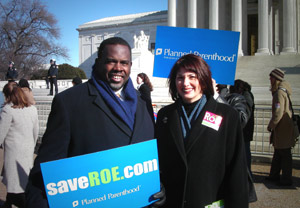United States abortion-rights movement
Movement advocating for legal access to abortion in the United States
The United States abortion-rights movement is a sociopolitical movement supporting the view that a woman should have the legal right to choose whether or not to continue a pregnancy to term. This movement is part of a broader global abortion-rights movement and is often referred to as the "pro-choice" movement in the United States.
History[edit | edit source]
The abortion-rights movement in the United States has its roots in the early 20th century, but it gained significant momentum in the 1960s and 1970s. The movement was galvanized by the Roe v. Wade decision in 1973, which recognized a woman's constitutional right to privacy, effectively legalizing abortion nationwide.
Early Advocacy[edit | edit source]
In the early 20th century, abortion was largely illegal in the United States, and women seeking abortions often faced dangerous conditions. Early advocates for abortion rights included Margaret Sanger, who also championed birth control and women's reproductive rights.
Roe v. Wade[edit | edit source]
The landmark 1973 Supreme Court case Roe v. Wade was a pivotal moment for the abortion-rights movement. The Court's decision struck down many state laws restricting abortion, asserting that the right to privacy under the Fourteenth Amendment extended to a woman's decision to have an abortion.
Post-Roe Developments[edit | edit source]
Following the Roe decision, the abortion-rights movement faced significant opposition from the anti-abortion movement, often referred to as the "pro-life" movement. Despite this opposition, abortion-rights advocates have continued to fight for access to safe and legal abortion services.
Key Organizations[edit | edit source]
Several organizations have played crucial roles in the abortion-rights movement in the United States. These include:
These organizations work to protect and expand access to abortion services through advocacy, education, and legal action.
Legal and Political Challenges[edit | edit source]
The abortion-rights movement has faced numerous legal and political challenges over the years. Various states have enacted laws aimed at restricting access to abortion, such as waiting periods, parental consent laws, and TRAP laws (Targeted Regulation of Abortion Providers).
Recent Developments[edit | edit source]
In recent years, the movement has focused on opposing restrictive state laws and advocating for federal protections for abortion rights. The 2022 Supreme Court decision in Dobbs v. Jackson Women's Health Organization overturned Roe v. Wade, leading to renewed efforts by abortion-rights advocates to secure legal protections at the state and federal levels.
Cultural Impact[edit | edit source]
The abortion-rights movement has significantly influenced American culture and politics. It has been a central issue in political campaigns and has shaped public discourse on women's rights and reproductive health.
Related pages[edit | edit source]
Search WikiMD
Ad.Tired of being Overweight? Try W8MD's physician weight loss program.
Semaglutide (Ozempic / Wegovy and Tirzepatide (Mounjaro / Zepbound) available.
Advertise on WikiMD
|
WikiMD's Wellness Encyclopedia |
| Let Food Be Thy Medicine Medicine Thy Food - Hippocrates |
Translate this page: - East Asian
中文,
日本,
한국어,
South Asian
हिन्दी,
தமிழ்,
తెలుగు,
Urdu,
ಕನ್ನಡ,
Southeast Asian
Indonesian,
Vietnamese,
Thai,
မြန်မာဘာသာ,
বাংলা
European
español,
Deutsch,
français,
Greek,
português do Brasil,
polski,
română,
русский,
Nederlands,
norsk,
svenska,
suomi,
Italian
Middle Eastern & African
عربى,
Turkish,
Persian,
Hebrew,
Afrikaans,
isiZulu,
Kiswahili,
Other
Bulgarian,
Hungarian,
Czech,
Swedish,
മലയാളം,
मराठी,
ਪੰਜਾਬੀ,
ગુજરાતી,
Portuguese,
Ukrainian
Medical Disclaimer: WikiMD is not a substitute for professional medical advice. The information on WikiMD is provided as an information resource only, may be incorrect, outdated or misleading, and is not to be used or relied on for any diagnostic or treatment purposes. Please consult your health care provider before making any healthcare decisions or for guidance about a specific medical condition. WikiMD expressly disclaims responsibility, and shall have no liability, for any damages, loss, injury, or liability whatsoever suffered as a result of your reliance on the information contained in this site. By visiting this site you agree to the foregoing terms and conditions, which may from time to time be changed or supplemented by WikiMD. If you do not agree to the foregoing terms and conditions, you should not enter or use this site. See full disclaimer.
Credits:Most images are courtesy of Wikimedia commons, and templates, categories Wikipedia, licensed under CC BY SA or similar.
Contributors: Prab R. Tumpati, MD

